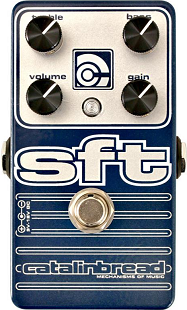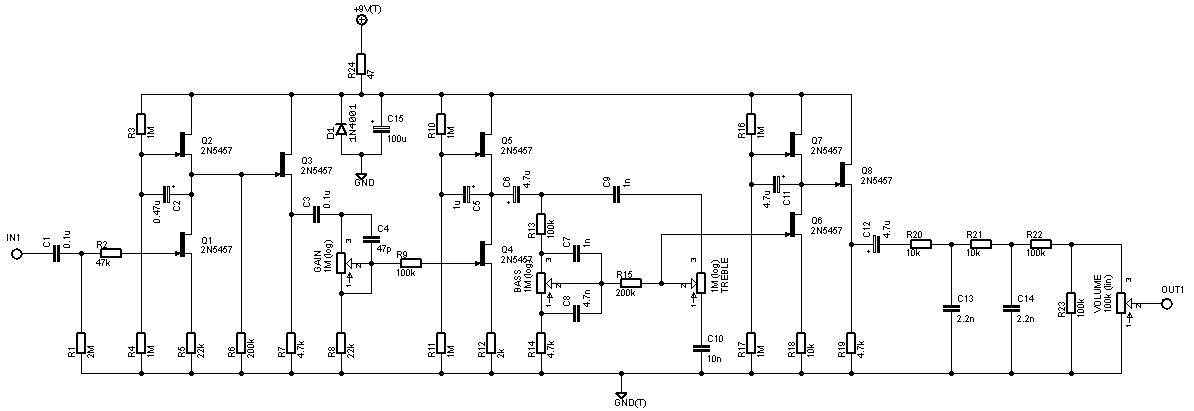Difference between revisions of "SFT"
(→Controls) |
|||
| Line 2: | Line 2: | ||
| __TOC__ | | __TOC__ | ||
|} | |} | ||
| − | [[Catalinbread]] SFT | + | [[Catalinbread]] developed the SFT as a bass [[overdrive]] pedal to serve as an emulator for the famous [[Ampeg]] [[SVT]] line of amps. Just as many guitar players took a liking to the [[Fender]] [[Bassman]] amp (which was also designed for electric bass), and just as the Bassman served as the basis for the [[Marshall]] [[JTM]], many guitar players have also taken a liking to Ampeg amps and used them for guitar as well. |
==Controls== | ==Controls== | ||
| Line 14: | Line 14: | ||
Not unlike the Catalinbread [[Manx Loaghtan]] fuzz, the SFT implements a [[Baxandall]] tone stack. | Not unlike the Catalinbread [[Manx Loaghtan]] fuzz, the SFT implements a [[Baxandall]] tone stack. | ||
| − | |||
; NOTE: Newer versions of the SFT have a push-button switch to toggle between '''"Stones"''' (up/disengaged) and '''"Stoner"''' (pressed down/engaged). Our version is older and does not have this button. According to the latest Catalinbread SFT Owner's Manual, that push button is a gain boost, pushing the button down increases the gain. Our experience is that the gain knob on our earlier model has a wider sweep, enabling all the gain that is available on the latest pedal. We suspect Catalinbread retooled the SFT with a gain potentiometer designed to offer a tighter range, and that range is shifted to "gainier" when the button is depressed. | ; NOTE: Newer versions of the SFT have a push-button switch to toggle between '''"Stones"''' (up/disengaged) and '''"Stoner"''' (pressed down/engaged). Our version is older and does not have this button. According to the latest Catalinbread SFT Owner's Manual, that push button is a gain boost, pushing the button down increases the gain. Our experience is that the gain knob on our earlier model has a wider sweep, enabling all the gain that is available on the latest pedal. We suspect Catalinbread retooled the SFT with a gain potentiometer designed to offer a tighter range, and that range is shifted to "gainier" when the button is depressed. | ||
| Line 22: | Line 21: | ||
==General Information== | ==General Information== | ||
| − | + | As has been previously mentioned, this pedal was designed primarily for bass, but music is sometimes promiscuous, with bass players using keyboard amps, and guitarists using bass amps, and so on and so on. Whatever a broke musician can cobble together to make something that sounds good is what they do. | |
| + | |||
| + | So that having been said, while the SFT was developed primarily as a bass overdrive, when the gain is turned up, and a guitar is plugged in, it not only can do good stoner "volume worship" tones, but it can also get pretty good sounding high-gain distortion as well, which ends up being a surprise to many. | ||
==Pedal Manual== | ==Pedal Manual== | ||
http://www.catalinbread.com/manuals/SFTmanual.pdf | http://www.catalinbread.com/manuals/SFTmanual.pdf | ||
| − | ==Phase Inversion== | + | ==Phase Inversion: Suspect that == |
| − | + | We're having a really hard time understanding the phase inversion dynamics in this circuit and pedal. If you take a look at the schematic, note that Q2 and Q3 are each accepting the same output from Q1, but then the signal splits and it can go through Q2 and/or Q3 - This means that the only reasonable conclusion we're drawing is that the transistors are both inverting, and keeping the signal original - then the regular and inverted signals are being processed and combined back together again, meaning that there should be a good amount of phase cancellation. This may take some more sophisticated understanding of signal flow. | |
| + | |||
| + | {| class="wikitable" style="left; margin-right:20px; background-color:#eeffee;" cellpadding="10" | ||
| + | |- | ||
| + | ! Schematic ID || Electronic Part || Action || Phase State | ||
| + | |- | ||
| + | | Q1 || 2N5457 || Inverts || Inverted | ||
| + | |- | ||
| + | | Q2 || 2N5457 || Does Not Invert || Not Inverted | ||
| + | |- | ||
| + | | Q3 || 2N5457 || Does Not Invert || Inverted | ||
| + | |- | ||
| + | | Q4 || 2N5457 || Inverts || Not Inverted | ||
| + | |- | ||
| + | | Q5 || 2N5457 || Does Not Invert || Not Inverted | ||
| + | |- | ||
| + | | Q6 || 2N5457 || Inverts || Inverted | ||
| + | |- | ||
| + | | Q7 || 2N5457 || Does Not Invert || Not Inverted | ||
| + | |- | ||
| + | | Q8 || 2N5457 || Does Not Invert || Inverted | ||
| + | |} | ||
==Schematic== | ==Schematic== | ||
Schematic obtained from this discussion board thread: http://musikding.rocks/wbb/index.php/Thread/16285-Catalinbread-SFT/?pageNo=12 | Schematic obtained from this discussion board thread: http://musikding.rocks/wbb/index.php/Thread/16285-Catalinbread-SFT/?pageNo=12 | ||
| − | + | The entry on the linked thread claims that the original schematic was downloaded from: http://juansolo.demon.co.uk/stompage/schematics/Catalinbread/SFT_Schematic.png which is no longer available as a site. Even "demon.co.uk" is apparently gone. It's a bit amusing in that there's no "Juansolo" that we've been able to find that corresponds to a British instrument effects pedal enthusiast with a goofy-fied Star Wars nickname. We do know that Juansolo was affiliated with Rej Bernier from GrindCustomsFX.com, but GrindCustomsFX.com also seems to have gone neglected too... | |
| + | |||
| + | Finally, we have found a particular "Juan Solo", but he is a singer from Mexico. He can be found at http://www.juansolo.net, and Youtube, and Twitter, and Instagram, etc, etc, etc... Clearly not the guy we'd be looking out for. | ||
| − | [[File:CBread_SFTSchematic.png|center|frame|<div style="text-align:right">Unaware of any copyright claims. Juansolo website | + | [[File:CBread_SFTSchematic.png|center|frame|<div style="text-align:right">Believed to be public domain. Unaware of any copyright claims. Juansolo's pedal website is gone.</div>]] |
==Artists== | ==Artists== | ||
| Line 44: | Line 68: | ||
---- | ---- | ||
;Additional Sources | ;Additional Sources | ||
| + | * https://youtu.be/_Fp7n5FgFQk | ||
Revision as of 07:27, 23 September 2018
Catalinbread developed the SFT as a bass overdrive pedal to serve as an emulator for the famous Ampeg SVT line of amps. Just as many guitar players took a liking to the Fender Bassman amp (which was also designed for electric bass), and just as the Bassman served as the basis for the Marshall JTM, many guitar players have also taken a liking to Ampeg amps and used them for guitar as well.
Controls

- Knob 1 - "Treble": Turn the knob increasingly clockwise to increase the treble frequencies.
- Knob 2 - "Bass": Turning the knob clockwise increases the bass frequencies.
- Knob 3 - "Volume": Turning the knob clockwise increases the volume output on the pedal.
- Knob 4 - "Gain": Turning the knob clockwise increases the amount of distortion available and output by the pedal.
- Footswitch 1 - "On/Off": This toggles the pedal between being engaged (on), and bypassed (off).
Not unlike the Catalinbread Manx Loaghtan fuzz, the SFT implements a Baxandall tone stack.
- NOTE
- Newer versions of the SFT have a push-button switch to toggle between "Stones" (up/disengaged) and "Stoner" (pressed down/engaged). Our version is older and does not have this button. According to the latest Catalinbread SFT Owner's Manual, that push button is a gain boost, pushing the button down increases the gain. Our experience is that the gain knob on our earlier model has a wider sweep, enabling all the gain that is available on the latest pedal. We suspect Catalinbread retooled the SFT with a gain potentiometer designed to offer a tighter range, and that range is shifted to "gainier" when the button is depressed.
Bypass:True
The Catalinbread SFT is True Bypass.
General Information
As has been previously mentioned, this pedal was designed primarily for bass, but music is sometimes promiscuous, with bass players using keyboard amps, and guitarists using bass amps, and so on and so on. Whatever a broke musician can cobble together to make something that sounds good is what they do.
So that having been said, while the SFT was developed primarily as a bass overdrive, when the gain is turned up, and a guitar is plugged in, it not only can do good stoner "volume worship" tones, but it can also get pretty good sounding high-gain distortion as well, which ends up being a surprise to many.
Pedal Manual
http://www.catalinbread.com/manuals/SFTmanual.pdf
Phase Inversion: Suspect that
We're having a really hard time understanding the phase inversion dynamics in this circuit and pedal. If you take a look at the schematic, note that Q2 and Q3 are each accepting the same output from Q1, but then the signal splits and it can go through Q2 and/or Q3 - This means that the only reasonable conclusion we're drawing is that the transistors are both inverting, and keeping the signal original - then the regular and inverted signals are being processed and combined back together again, meaning that there should be a good amount of phase cancellation. This may take some more sophisticated understanding of signal flow.
| Schematic ID | Electronic Part | Action | Phase State |
|---|---|---|---|
| Q1 | 2N5457 | Inverts | Inverted |
| Q2 | 2N5457 | Does Not Invert | Not Inverted |
| Q3 | 2N5457 | Does Not Invert | Inverted |
| Q4 | 2N5457 | Inverts | Not Inverted |
| Q5 | 2N5457 | Does Not Invert | Not Inverted |
| Q6 | 2N5457 | Inverts | Inverted |
| Q7 | 2N5457 | Does Not Invert | Not Inverted |
| Q8 | 2N5457 | Does Not Invert | Inverted |
Schematic
Schematic obtained from this discussion board thread: http://musikding.rocks/wbb/index.php/Thread/16285-Catalinbread-SFT/?pageNo=12
The entry on the linked thread claims that the original schematic was downloaded from: http://juansolo.demon.co.uk/stompage/schematics/Catalinbread/SFT_Schematic.png which is no longer available as a site. Even "demon.co.uk" is apparently gone. It's a bit amusing in that there's no "Juansolo" that we've been able to find that corresponds to a British instrument effects pedal enthusiast with a goofy-fied Star Wars nickname. We do know that Juansolo was affiliated with Rej Bernier from GrindCustomsFX.com, but GrindCustomsFX.com also seems to have gone neglected too...
Finally, we have found a particular "Juan Solo", but he is a singer from Mexico. He can be found at http://www.juansolo.net, and Youtube, and Twitter, and Instagram, etc, etc, etc... Clearly not the guy we'd be looking out for.
Artists
We are currently unaware of any artists actively using the pedal now, or who have in the past.
- Additional Sources
